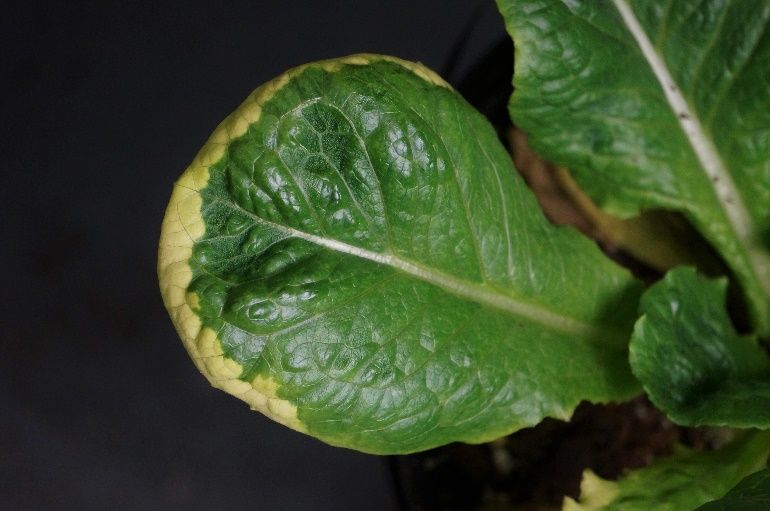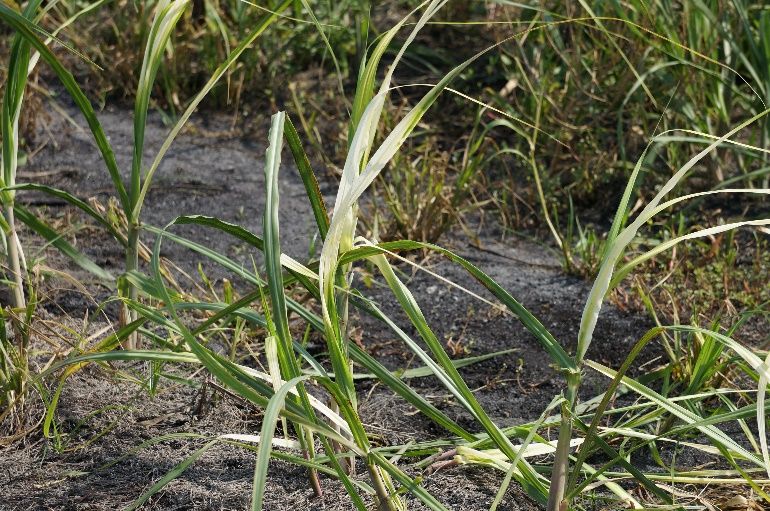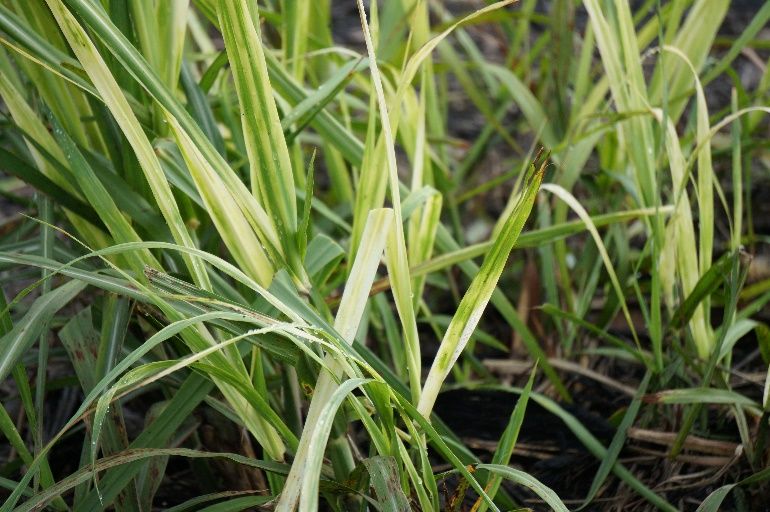Sugarcane is a major row crop cultivated on organic soils in the Everglades Agricultural Area and surrounding mineral soils in southern Florida. The crop is grown in rotation with rice and several vegetables including sweet corn, lettuce, green bean, and radish. Weed management is a major cost associated with production of these crops. Multiple tactics based on a combination of preventative, cultural, mechanical, and chemical control practices are used for effective weed management. Chemical weed control using herbicides is the most widely used method to mitigate damaging effects of weeds on these crops. However, unintended damage or injury to nontarget crops due to off-target movement or residual effects of herbicides can occur. Herbicide injury symptoms vary considerably depending on the herbicide mode of action. The herbicide mode of action describes the plant process or enzyme that the herbicide disrupts. Herbicides with the same mode of action produce similar injury symptoms. This article describes how to diagnose injury symptoms from herbicides commonly used in sugarcane and rotational crops in southern Florida based on their mode of action. This information is intended to help growers to pinpoint sources of injury from off-target movement, carryover, or improper use of herbicides.
Photosynthesis Inhibitors (Photosystem II)
These herbicides inhibit photosynthesis by binding to a protein within the photosystem II complex in plant chloroplasts. The binding blocks electron transport and stops carbon dioxide fixation and energy production needed for plant growth. In addition, toxic radicals are produced, which cause the destruction of chlorophyll and cell membranes. These herbicides are generally applied preemergence and absorbed by roots, and they move upward to the shoot. When applied postemergence to the foliage, these herbicides are nonmobile and act as contact herbicides. This means they are only active through contact with no movement to other parts of the plant. Susceptible plants will die faster under light conditions after a foliar application compared to soil uptake.
Symptoms
Injury symptoms develop over several days. The symptoms start with the oldest leaves and progress to the top new leaves. Symptoms include yellowing of leaf margins and interveinal chlorosis (yellowing between veins). Injured leaf tissue eventually becomes necrotic (i.e., turns brown and dies). For nonmobile herbicides such as bentazon, injury is manifested as yellowing or bronzing of leaves, which eventually turn brown and die. Injury from bentazon is confined to foliage that comes in contact with the herbicide.
Herbicides That Inhibit Photosynthesis
Table 1.

Credit: Calvin Odero, UF/IFAS

Credit: Calvin Odero, UF/IFAS

Credit: Calvin Odero, UF/IFAS

Credit: Calvin Odero, UF/IFAS

Credit: Calvin Odero, UF/IFAS
Pigment Inhibitors
These herbicides prevent plants from forming photosynthetic pigments. The first group of herbicides inhibits different enzymes in the carotenoid biosynthetic pathway that protects chlorophyll from excessive light and photo-oxidation. In the absence of carotenoids, chlorophyll is degraded rapidly in the presence of high light intensities. When chlorophyll synthesis is inhibited, plant foliage turns white and slow plant death occurs. The second group inhibits deoxy-D-xylulose phosphate synthase (DOXP), a key component to plastid isoprenoid synthesis. These herbicides can be applied preemergence or postemergence and are absorbed by both roots and foliage.
Symptoms
Injury is expressed as bleached white foliage that becomes translucent at the tips. New growth becomes bleached within a few days after exposure to the herbicide. Death occurs after one to several weeks depending on the herbicide dose. Plants often recover from light bleaching, but total bleaching results in necrotic tissues and death.
Herbicides That Inhibit Pigment Synthesis
Table 2.

Credit: Calvin Odero, UF/IFAS

Credit: Calvin Odero, UF/IFAS

Credit: Calvin Odero, UF/IFAS

Credit: Calvin Odero, UF/IFAS

Credit: Calvin Odero, UF/IFAS
Cell Membrane Disruptors
The cell membrane-disrupting herbicides include diphenyl ether and bipyridylium herbicide families that are postemergence contact herbicides. The herbicides are activated by exposure to sunlight, which leads to formation of highly unstable free radicals and peroxides that destroy plant tissue by rupturing cell membranes. Very little translocation of these herbicides to other regions of the plant occurs due to rapid destruction of cell membranes. High light intensities increase the rate of injury symptom development. On bright, sunny days, herbicide injury symptoms can occur in less than 1 to 2 hours with death occurring within 1 to 3 days. Bipyridyliums generally adsorb to soil organic matter and colloids, making them inactive from soil uptake, while some diphenyl ethers have both foliar and soil activity.
Symptoms
The first visible damage on plant foliage is the appearance of water-soaked or dark-green spots within a few hours, followed by browning and necrotic spots. Water soaking is indicative of membrane damage. Reddish-colored spotting and speckling of foliage may occur with the diphenyl ether herbicides.
Herbicides That Disrupt Cell Membranes
Table 3.

Credit: Calvin Odero, UF/IFAS

Credit: Calvin Odero, UF/IFAS

Credit: Calvin Odero, UF/IFAS

Credit: Calvin Odero, UF/IFAS

Credit: Calvin Odero, UF/IFAS

Credit: Calvin Odero, UF/IFAS
Lipid Synthesis Inhibitors
These herbicides inhibit the formation of fatty acids essential for the production of plant lipids. Lipids are a critical component of cell membranes and new plant growth. Lack of lipids results in reduced cell membrane production, no new growth, and plant death. The herbicides are absorbed through foliage and translocated to meristematic regions in susceptible plants. Lipid synthesis inhibitor herbicides are used for postemergence control of grasses with little to no effect on broadleaf plants.
Symptoms
Injury symptoms do not become visible until several days after exposure. The herbicides require approximately 1 week or more to kill the plant, although cessation of plant growth occurs soon after treatment. The herbicides cause discoloration (or yellowing) and disintegration of meristematic tissue followed by death of new leaf tissue. The base of the leaves becomes brown, mushy, and rotten. Because these herbicides destroy the growing points of grasses, the newest leaf tissue usually pulls easily from the whorl, exposing decaying tissue.
Herbicides That Inhibit Lipid Synthesis
Table 4.

Credit: Calvin Odero, UF/IFAS

Credit: Calvin Odero, UF/IFAS

Credit: Calvin Odero, UF/IFAS

Credit: Calvin Odero, UF/IFAS
Seedling Growth Inhibitors
These herbicides inhibit root or shoot growth of germinating seedlings. They are applied preemergence or preplant incorporated for control of annual grasses and some broadleaf weeds. The herbicides interfere with new plant growth and limit normal development of seedlings in the soil. There is little to no movement of these herbicides in plants.
Dinitroaniline herbicides are one group of growth inhibitors that are generally bright yellow in color and are often called yellow herbicides. They are absorbed by emerging shoots and roots, and they inhibit development by disrupting cell division (mitosis) primarily in the meristems located at the root and shoot tips. Although these herbicides inhibit early seedling growth, they do not prevent germination. Chloroacetamides are among the most widely used shoot growth inhibitor herbicides. They inhibit very long chain fatty acids (VLCFA) that are important constituents of the plasma membrane. The loss of VLCFA stops the function of the plasma membrane, resulting in loss of cell integrity and eventual plant death. Chloroacetamides are soil-applied for control of annual grasses and a few small-seeded broadleaf species before they emerge; however, they do not inhibit seed germination. They are absorbed by roots of broadleaf plants and by shoots of grasses.
Symptoms
With dinitroaniline herbicide injury, emerged grasses have deformed, short, and swollen shoots. The stem below the cotyledon in broadleaf plants is swollen and cracked. Injured plants are stunted and have crinkled leaves. Inhibition of lateral or secondary root growth is the most noticeable symptom for both grasses and broadleaf plants. The tips of lateral roots become short and stubby. Symptoms from chloroacetamide herbicide injury include stunted plants that fail to emerge. Grasses that emerge appear twisted and malformed and fail to unroll from the whorl, giving the plant a “buggy-whip” appearance. Broadleaves may have crinkled leaves and shortened midveins, producing a “drawstring” effect on the leaf tip.
Herbicides That Inhibit Seedling Growth
Table 5.

Credit: Calvin Odero, UF/IFAS

Credit: Calvin Odero, UF/IFAS
Growth Regulators
Growth regulator herbicides are also known as synthetic auxin herbicides because they affect plant growth in a similar way as the natural plant auxin, indoleacetic acid (IAA). The herbicides mimic IAA and upset natural hormonal balance in plants. These herbicides hasten shoot growth and inhibit root growth. They are primarily postemergence applied, mainly to control broadleaf weeds in grass crops. They are readily absorbed through roots and foliage, and they translocate in susceptible plants to areas of new plant growth.
Symptoms
The herbicides produce profound effects on growth and structure of broadleaf plants, including epinastic bending and twisting of stems and petioles, stem swelling (particularly at nodes), leaf malformations (cupping, curling, crinkling, parallel venation, leaf strapping), and stunted root growth. Grasses exhibit rolled leaves (onion leafing), abnormal brace root formation, and leaning stems.
Growth-Regulating Herbicides
Table 6.

Credit: Calvin Odero, UF/IFAS

Credit: Calvin Odero, UF/IFAS

Credit: Calvin Odero, UF/IFAS
Amino Acid-Inhibiting Herbicides
These herbicides inhibit acetolactate synthase (ALS), an enzyme involved in the synthesis of branch chain amino acids—specifically valine, leucine, and isoleucine. The amino acids are building blocks of proteins required for plant growth. These herbicides are readily absorbed by plant roots and foliage and translocated to all parts of the plants. Generally, these herbicides accumulate in areas of new growth where their effects are first observed. The
ALS-inhibiting herbicides are used at low rates and applied preemergence or postemergence.
Glyphosate is an herbicide that also inhibits amino acids but acts on the enzyme EPSPS (5-enolpyruvylshikimate-3-phosphate synthase). The enzyme is involved in the synthesis of three essential aromatic amino acids: phenylalanine, tyrosine, and tryptophan. Depletion of these amino acids reduces protein synthesis and subsequently causes inhibition of plant growth. Glyphosate is a nonselective postemergence herbicide that controls annual and perennial weeds. It is readily absorbed through foliage, and it translocates to all plant parts, including roots or vegetative propagules of perennial weeds. Glyphosate is inactive in soil because of its rapid and strong adsorption to soil.
Symptoms
Injury symptoms from ALS herbicides develop slowly and are not visible until several days after treatment. Symptoms include stunting, interveinal chlorosis (yellowing), red or purple leaf venation, and necrosis (death) apparent 1 to 4 weeks after treatment, depending on the species and environmental conditions. In grasses, they can cause improper leaf unfurling and translucent leaf tissue. Injury symptoms from glyphosate include growth inhibition or stunting followed by noticeable chlorosis (yellowing) of new tissue that progresses to older tissue. Development of symptoms is slow, depending on rate, plant species, and environmental conditions. Treated plants turn yellow in 5 to 7 days, then turn brown and die in 10 to 14 days. Grasses exposed to sublethal rates of glyphosate can have a chlorotic band across the leaves in the whorl of the plant.
Herbicides That Inhibit Amino Acid Synthesis
Table 7.

Credit: Calvin Odero, UF/IFAS

Credit: Calvin Odero, UF/IFAS

Credit: Calvin Odero, UF/IFAS

Credit: Calvin Odero, UF/IFAS

Credit: Calvin Odero, UF/IFAS
Microtubule Synthesis (DHP) Inhibitor
Asulam is a carbamate herbicide that appears to inhibit cell division and meristematic growth by interfering with microtubule assembly or function. Microtubules primarily help to support and shape the cell. Asulam also inhibits dihydropteroate synthase (DHP), an enzyme involved in folic acid required for biosynthesis of purine nucleotides, which are components of DNA and RNA. Asulam is readily absorbed by foliage in susceptible species and translocated throughout the plant to growing points; however, the degree of translocation is species dependent. It is used for postemergence control of many grass weeds.
Symptoms
Injury symptoms include chlorosis (yellowing) of young leaves and stunting followed by necrosis. Growing points are usually killed in 1 to 2 weeks, while older mature leaves reach senescence much more slowly. It can take up to 4 weeks for death of the entire plant to occur.
Herbicides That Inhibit Microtubule Synthesis
Table 8.

Credit: Calvin Odero, UF/IFAS

Credit: Calvin Odero, UF/IFAS